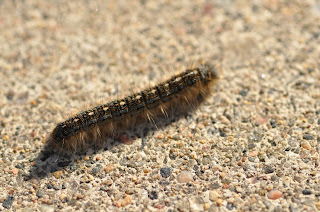The garden is changing its wardrobe to the fall colors as we enjoy the last days of warm weather. I think today is actually THE last day, according to the weather report. I felt it was probably safe to pack away the summer clothes inside as well, to make room for the warmer items.

The ever-present screeching squirrel seems to have done a number on the flower bed closest to the house. There appears to be an arm-sized tunnel dug under the bean plant. I guess screaming at us from under the stairs at our front door wasn't good enough.
 |
| Driveway perennial bed. The Hansa rose is reblooming! |
I have faithfully dead-headed the perennials, hoping to squeeze a few late blooms out of the delphiniums (or at least reduce the volunteer seedlings). Other than the squirrel, we have had few pests this year, including insects. The bunny, while thankfully eating the dandelions, did however much away at the peas and beans in the vegetable garden. Oh well, we still had some to eat for ourselves. I can put up with that.


Among the perennials in the large raised bed, I randomly planted a variety of sunflower seeds this spring. The ones on the sunniest end are now blooming and I hope to see a few more. I planted pollen-free sunflowers, which are probably desired by people who want them as mess-free cutflowers, but I mostly just want them to look good outside. I love the combination of the coneflowers (Echinacea) with the sunflowers. They bloom at the same time and the deep pink looks great against the golden sunflowers. The garden-Pinterest of my brain is going to lock this in as an idea to replicate in the future, with even more sunflowers and more Echinacea. The cosmos would also look great in front of the tall sunflowers.
 |
| Geese honking over our yard, heading south for the winter. |
I pulled out all the
Papaver rhoeas, the bright pink annual poppies growing in the center raised bed. They were going brown and had already spread their seed. With them removed, we can now see the few self-seeded cosmos that were fighting their away up amid the poppies. Cosmos are a wonderful late season annual. They are also as easy as throwing a few seeds in the dirt in spring. If you have a small flower bed, the short ones would look best.
 |
| Pink cosmos with the lilies in the center raised bed. |
The perennials have limited activity at the moment. I see a few blooms starting on the Morden mum and Aster dumosus, but these are pretty small or overgrown with other plants (over-exuberant spirea), so their contribution is mostly invisible!
 |
| Foreground: alpine bed. Background: The large raised bed filled with perennials. |
Otherwise, I have been organizing and cleaning up the gardening tools and supplies. Not just for the winter, but because we are soon moving on from our yard and home. I have had fun with all the plants that thrived or failed here, learning a lot about them. I have ideas on new things I would like to try (branching out into red or orange flowers, which have excluded from this yard) and dreaming about the garden challenges we will meet in our eventual new property, which is in hardiness zone 6 of southern British Columbia! I'm imagining a focus on xeriscaping will be the new challenge, while we enjoy an orchard and perhaps some grapevines. I have enjoyed all the feedback on this garden and will continue on gardening with enthusiasm, though I am really looking forward to throwing out the insect repellent as a necessary gardening tool.
 The ever-present screeching squirrel seems to have done a number on the flower bed closest to the house. There appears to be an arm-sized tunnel dug under the bean plant. I guess screaming at us from under the stairs at our front door wasn't good enough.
The ever-present screeching squirrel seems to have done a number on the flower bed closest to the house. There appears to be an arm-sized tunnel dug under the bean plant. I guess screaming at us from under the stairs at our front door wasn't good enough. 

 Among the perennials in the large raised bed, I randomly planted a variety of sunflower seeds this spring. The ones on the sunniest end are now blooming and I hope to see a few more. I planted pollen-free sunflowers, which are probably desired by people who want them as mess-free cutflowers, but I mostly just want them to look good outside. I love the combination of the coneflowers (Echinacea) with the sunflowers. They bloom at the same time and the deep pink looks great against the golden sunflowers. The garden-Pinterest of my brain is going to lock this in as an idea to replicate in the future, with even more sunflowers and more Echinacea. The cosmos would also look great in front of the tall sunflowers.
Among the perennials in the large raised bed, I randomly planted a variety of sunflower seeds this spring. The ones on the sunniest end are now blooming and I hope to see a few more. I planted pollen-free sunflowers, which are probably desired by people who want them as mess-free cutflowers, but I mostly just want them to look good outside. I love the combination of the coneflowers (Echinacea) with the sunflowers. They bloom at the same time and the deep pink looks great against the golden sunflowers. The garden-Pinterest of my brain is going to lock this in as an idea to replicate in the future, with even more sunflowers and more Echinacea. The cosmos would also look great in front of the tall sunflowers. 















































